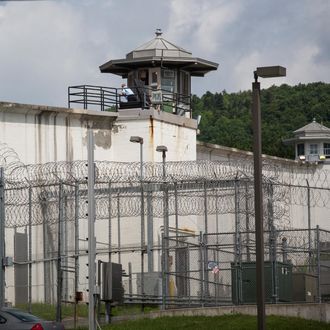
On Friday, shortly after the morning’s head count, three inmates at Central Men’s Jail in Orange County, California, executed an elaborate escape. They somehow managed to cut through the steel in the wall behind their beds, then maneuvered through the prison’s plumbing system until they reached the (unsecured) roof. There, they lowered the rope they’d fashioned out of bedsheets, and — as if they were characters in a clichéd movie about a prison break — fled. They’re “extremely dangerous,” and they’re still on the run.
As Jaime Fuller noted over at Daily Intelligencer on Monday, if this story sounds vaguely like you’ve heard it recently, it’s because you have. Last summer, a pair of inmates at Clinton Correctional Facility worked together to escape, hatching a plan that “involved manhole covers, frozen hamburger meat, and paintings of Barack Obama and Hillary Clinton,” as Fuller wrote.
To be sure, although they always make headlines, prison escapes are actually not very common — they’ve even decreased in recent years, according to some estimates. The best way to guard against prison breaks, of course, are actual, literal guards; the higher the officer-to-inmate ratio in a given prison, the lower its rate of escapees. But of those who do make it out, or at least make a mighty attempt at it, what, if anything, do they have in common? And is there any way criminal psychologists might one day be able to predict which inmates are most likely to try to flee? In a good piece for Pacific Standard, writer Lauren Kirchner addresses these questions and finds two major factors that prison escapees tend to have in common:
They’re young. Researchers who studied male inmates in Georgia examined a variety of characteristics of the individuals who had escaped, but there was one item that most strongly predicted escapes: “youthfulness.” The younger the average age of the men in the prison, the more likely someone was to escape. A larger-scale and longer-term study that examined ten years’ worth of data on prison escapes in the U.S. later echoed that finding. “[R]ace and gender of the felons did not seem to be a factor in determining their likelihood of attempting an escape,” wrote Kirchner. Only their age did.
They’re more likely to be dealing with mental illness. A recent report called U.S. prisons and jails the nation’s “new asylums,” in that the “number of individuals with serious mental illness in prisons and jails now exceeds the number in state psychiatric hospitals tenfold.” The literature on prison escapees also suggests that the incarcerated mentally ill may be more likely to escape. It’s an older study, but research on female prisoners from the 1970s found, among other things, that the escapees were more likely to have a history of psychiatric treatment than the non-escapees in the study.
It’s a tricky and unclear business, in other words, despite decades of criminal psychologists attempting to estimate “escape probability.” Most escapees are caught eventually, though the whereabouts of the California trio is still unknown. There’s a $50,000 potential reward in it for you if you know anything. (Do you?)

